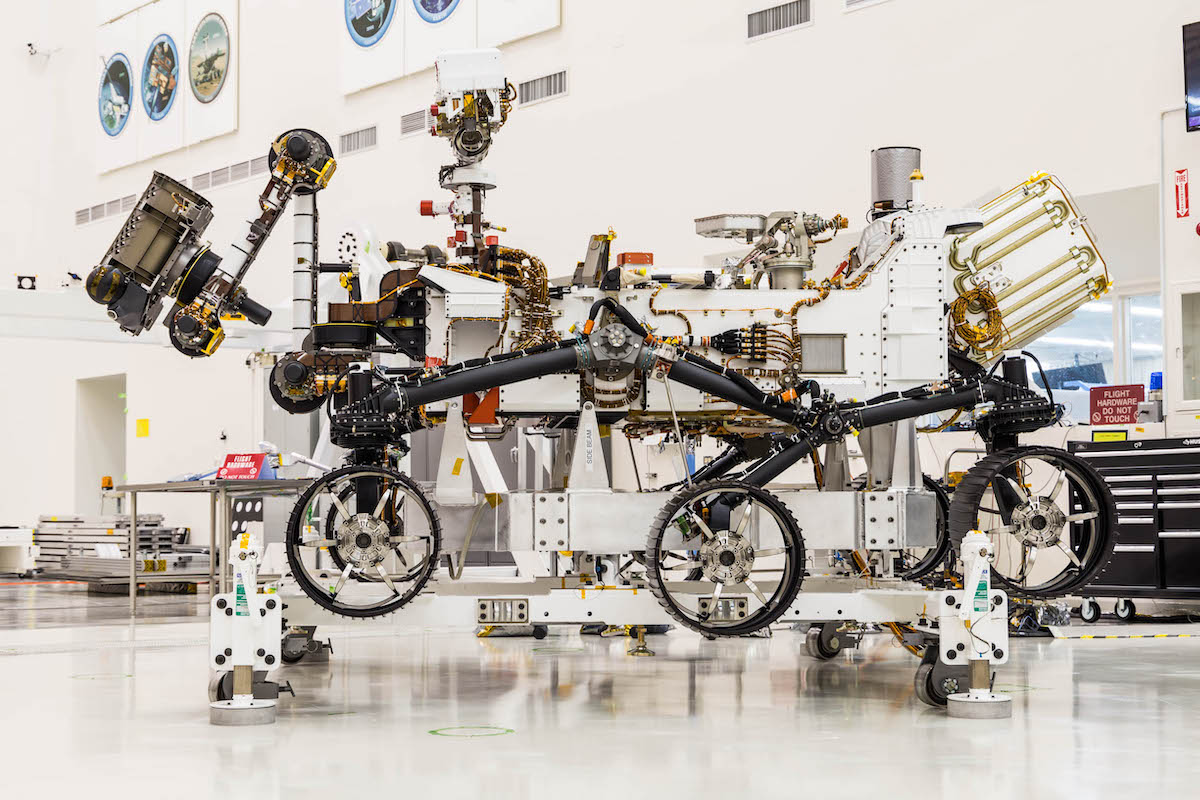
Fresh off its first terrestrial test drive, NASA’s Mars 2020 rover was displayed to media last week at the Jet Propulsion Laboratory in California before it’s packed up and flown across the country to Cape Canaveral in February to begin final launch preparations for liftoff in July.
The six-wheeled robot is similar in appearance to NASA’s Curiosity rover, which has explored Mars since August 2012, but the Mars 2020 rover carries an upgraded suite of scientific instruments, plus mechanisms to collect, seal and store samples of powder drilled and cored from Martian rocks.
The rock specimens will be picked up by a future robotic mission to return the samples to Earth for detailed analysis. Scientists hope to find evidence of ancient life.
The Mars 2020 rover also carries a miniature flying helicopter drone, which will deploy after landing to become the first aircraft to fly in the atmosphere of another planet. It also features aluminum wheels with thicker skin and modified treads to avoid damage observed on Curiosity’s wheels on Mars.
“Mars 2020, in the grand scheme of things, is looking for signs of ancient life,” said Zach Ousnamer, a mechanical engineer on the Mars 2020 assembly, test and launch team. “We’re going to land in Jezero Crater, which is an ancient river delta. Here on Earth, we know those are hot spots for life, so we’re going to go to one on Mars in hopes of finding (life) there.”
NASA invited reporters and photographers to see the Mars 2020 rover Dec. 27 inside the Spacecraft Assembly Facility at the Jet Propulsion Laboratory in Pasadena, California. Members of the media, clad in clean room “bunny suit” attire, were able to photograph the rover, the Mars 2020 descent stage, and the cruise stage, or the spacecraft that will ferry the rover from Earth to Mars.

The Mars 2020 rover is about the size of a small car, measuring around 10 feet (3 meters) long, 9 feet (2.7 meters) wide and 7 feet (2.2 meters) tall, according to NASA. Those dimensions closely match the size of the Curiosity rover.
But the Mars 2020 rover is slightly heavier than Curiosity. NASA’s next rover has a fully-loaded weight of 2,260 pounds (1,025 kilograms), or about 278 pounds (126 kilograms) more than Curiosity.
Engineers at JPL completed assembly of the Mars 2020 rover a few months ago, then put the craft through a series of tests to ensure it is ready for the trip to the Red Planet. The test team checked out the separation system that will release the rover from its sky crane descent stage — a rocket pack that will lower the rover on a bridle to the Martian surface — then placed the rover in a thermal vacuum chamber to expose it to the cold, low-pressure conditions it will encounter after landing on Mars.
On Dec. 17, the rover performed its first test drive inside its assembly building at JPL.
“Mars 2020 has earned its driver’s license,” said Rich Rieber, the lead mobility systems engineer for Mars 2020, in a statement. “The test unambiguously proved that the rover can operate under its own weight and demonstrated many of the autonomous-navigation functions for the first time. This is a major milestone for Mars 2020.”
The Mars 2020 rover’s 7-foot-long (2.1-meter) robotic arm carries an 99-pound (45-kilogram) turret package containing the PIXL and SHERLOC instruments, which will scan Martian rocks to determine their chemical composition and search for organic materials.
The turret also has cameras, which the arm can place against Martian rocks to obtain fine-scale measurements, and holds a percussive drill and coring mechanism to collect rock samples for eventual return to Earth.
The Mars 2020 rover also carries the SuperCam instrument, an intricate suite of sensors, including a camera, laser and spectrometers, designed to zap Martian rocks from more than 20 feet (6 meters) away to measure their chemical and mineral make-up, with the ability to identify organic molecules.
Developed by an international team in the United States, France and Spain, the SuperCam instrument is an upgraded version of the ChemCam instrument currently operating on NASA’s Curiosity Mars rover.
The instruments mounted inside the Mars 2020 rover’s main body include MOXIE, which will demonstrate the production of oxygen from carbon dioxide in the atmosphere of Mars, a capability that future astronaut explorers could use on the Red Planet. A Norwegian-developed ground-penetrating radar on Mars 2020 will study the Red Planet’s underground geologic structure.
The mission also carries a weather station and 23 cameras, including the first camera on Mars with a zoom function. Mars 2020 also has two microphones to record the sound of the rover’s landing, Martian wind and the sound of the rover’s laser zaps, according to NASA.

The next step on the road to Mars 2020’s launch will be the shipment of the rover, descent stage and cruise stage to NASA’s Kennedy Space Center in Florida. The components will be transported from California to Florida in two shipments, with the rover scheduled to arrive at KSC in February on a U.S. military cargo plane.
The other major piece of the mission — the heat shield — has already arrived at the Florida spaceport. The nearly 15-foot-diameter (4.5-meter) heat shield, along with the Mars 2020 mission’s back shell structure, arrived at Kennedy on Dec. 11 from a Lockheed Martin factory near Denver.
A team of JPL engineers will travel to Kennedy to assemble all the pieces of the Mars 2020 mission ahead of liftoff in July on a United Launch Alliance Atlas 5 rocket.
The rover and descent stage will be packed inside the heat shield and back shell, the aerodynamic structure which will protect the robot during its scorching entry into the Martian atmosphere. The cruise stage will be mated to the Mars 2020 entry vehicle and then encapsulated inside the Atlas 5’s payload fairing inside the Payload Hazardous Servicing Facility at Kennedy, then trucked to nearby pad 41 at Cape Canaveral Air Force Station for installation on top of the launcher.
Once on top of the rocket inside pad 41’s vertical hangar, teams will add the Mars 2020 rover’s nuclear power generator.
The launch window for the Mars 2020 mission opens July 17 and closes Aug. 5, when Earth and Mars are in the proper positions in the solar system to enable a direct interplanetary journey. The rover is scheduled to land on Mars at Jezero Crater on Feb. 18, 2021.
The Mars 2020 rover will get an official name before its July launch.
NASA invited U.S. students last year to submit essays with their ideas for a name for the rover, and the space agency is expected to reveal finalists later this month, then announce the name selection in February.
Additional photos of the Mars 2020 rover, descent stage and cruise stage are posted below.






Email the author.
Follow Stephen Clark on Twitter: @StephenClark1.



